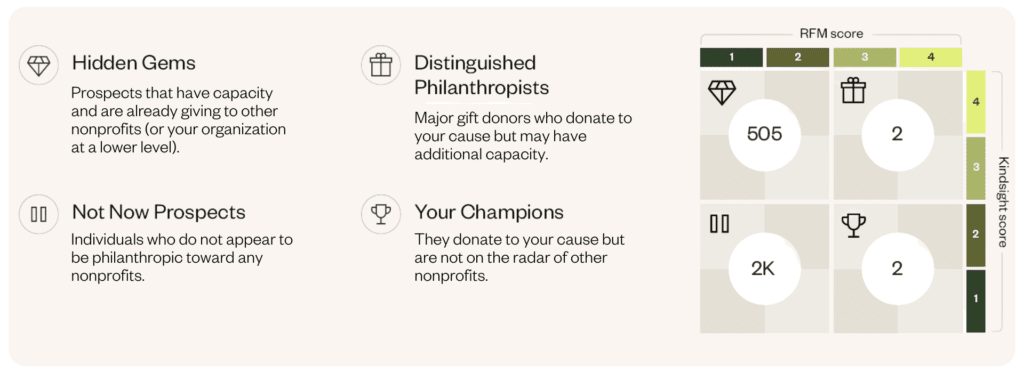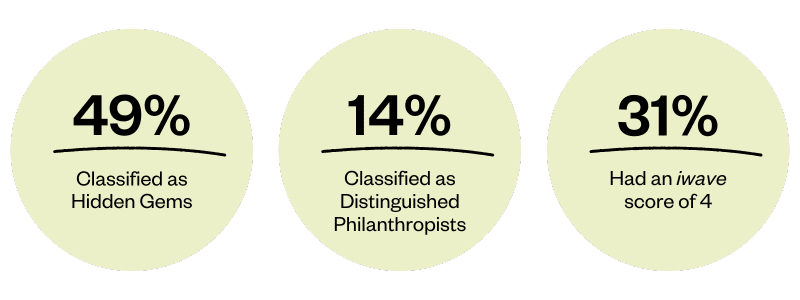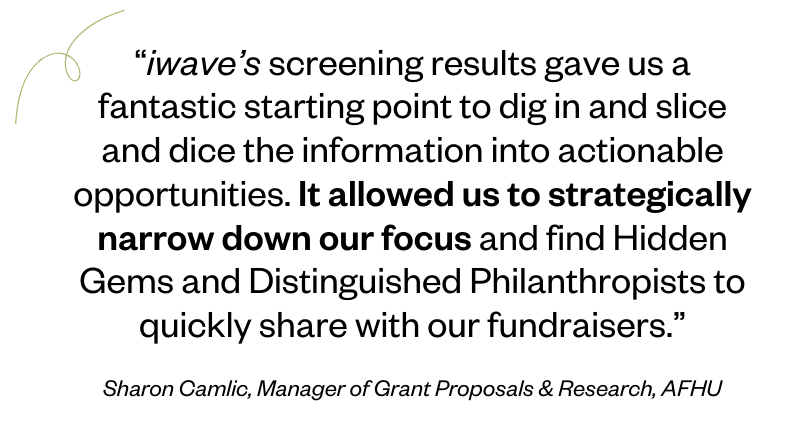
Learn how American Friends of the Hebrew University (AFHU) identified new foundation donors already in their database, enabling them to focus on their most promising prospects.
Many fundraising organizations are increasingly looking to foundations to meet their fundraising goals. However, identifying the right foundations to target can be a time-consuming and challenging process, requiring significant research to determine which opportunities align with an organization’s mission. Often, nonprofits focus so intently on acquiring new donors that they overlook untapped potential within their existing database. This was the case for American Friends of the Hebrew University (AFHU), a U.S.-based nonprofit dedicated to raising funds for the Hebrew University of Jerusalem in Israel.
AFHU focuses primarily on major gift fundraising but was interested in exploring opportunities to better engage with institutional funders. Recognizing this as an area of growth, the organization wanted to take a more strategic approach to identifying and prioritizing foundation prospects, particularly since the Hebrew University was pursuing enhanced global support.
The challenge: A large database with no system for prioritization
Eileen Hume, Chief Strategy Officer, and Sharon Camlic, Manager of Grant Proposals & Research at AFHU, faced a common nonprofit challenge—a large repository of data without an efficient method for prioritizing prospects.
According to Eileen, “We had been adding a lot of foundation prospects into our database, whether they were engaging with us or not, whether they were donating or not. So we actually had a very large pile of information…and not a whole lot of insight about how to prioritize or where to start.”
Compounding this issue was the labor-intensive nature of traditional foundation research. AFHU staff often relied on manually sifting through 990 forms and annual reports to assess prospect alignment, a time-consuming way to uncover meaningful insights. The team needed a solution that could allow them to prioritize effectively, moving their focus from solely identifying new prospects to better leveraging existing data and relationships.
AFHU sought to develop a systematic way to identify and segment their foundation prospects and allocate resources wisely. Building this framework would require moving beyond surface-level data to a database that could effectively direct their outreach efforts.
The solution: A strategic approach to foundation research with iwave
To address these challenges, AFHU partnered with Jennifer Filla, CEO of Aspire Research Group, and Jackie Beres, Consultant & Grant Writer, at Think And Ink Grants to screen and analyze their existing database. Utilizing iwave, within Kindsight’s Fundraising Platform, leveraging its capacity for data integration and insight generation, they were able to analyze internal and external data more cohesively.
The process began with a kick-off meeting that defined AFHU’s goals, including relevant keywords, themes, and priorities derived from their strategic plan. Jackie emphasized the importance of collecting as much information as possible for fundraising success, “How much have they given? How many times have they given? First and last gift, largest gift—all of those details help build lasting relationships.” With these questions in mind, AFHU provided a range of internal data on past donor giving histories.
Using iwave, external data was pulled to map foundation assets, giving histories, and indicators of alignment with AFHU’s mission. The platform’s algorithm combined internal and external data to generate Recency, Frequency, and Monetary (RFM) scores, alongside affinity scores, which measured a foundation’s history of supporting similar causes. This nuanced scoring process allowed the organization to segment prospects into actionable categories, such as “Hidden Gems,” “Distinguished Philanthropists,” “Champions,” and “Not Now.”

iwave streamlined the previously manual process into a more efficient model. “iwave is like your one-stop shop process for pulling all of that data together,” Jackie noted, highlighting the platform’s ability to save time and deliver actionable insights. Jenniffer agreed, “I haven’t seen this ability anywhere else to take a file of prospects or foundations, screen it to append this additional data onto it, and then prioritize quickly and efficiently as opposed to looking up each name at a time. That’s a huge difference here.”
The newly segmented database enabled AFHU to identify strong prospects from its existing donor base, focusing their efforts on foundations aligned with their mission and priorities while uncovering potential opportunities for stewardship and engagement.
The outcome: Actionable segmentation and untapped potential
The results of the screening were significant. iwave’s analysis revealed that nearly 49% of AFHU’s foundation prospects could be classified as “Hidden Gems,” while an additional 14% were “Distinguished Philanthropists.” More than half of the database had top-tier iwave scores, and close to half presented strong RFM scores, indicating a high likelihood of giving. Additionally, 31% of the database had an iwave score of 4, signifying promising giving potential.

This segmentation allowed the organization to break its database into manageable, prioritized lists. Jackie explained, “It’s about taking bite-sized pieces so you can start with the top tier in your priority list—your Hidden Gems and Distinguished Philanthropists—and work your way through.” These insights enabled AFHU to allocate time and resources more strategically, focusing on cultivating relationships with their best candidates.

iwave also helped AFHU confirm the value of stewardship for existing foundation donors. For example, “Champions,” or foundations that consistently gave annual gifts, became a focus for delivering tailored stewardship programs designed to foster long-term relationships. Jennifer shared “Your best prospects are your current or previous donors. They are worthy of time and investment.” Even disqualified foundations were flagged for future consideration if personal connections or strategic opportunities later arose.
By using iwave, AFHU shifted its approach from managing an overwhelming list of unknowns to focusing on actionable data. This allowed the organization to identify high-potential opportunities, avoid wasting energy on unpromising prospects, and fully leverage the strength of their existing donor relationships.

AFHU’s collaboration with Aspire Research Group and Think And Ink Grants, and their use of iwave enabled the organization to hone its approach to foundation prospecting. They avoided the costly trap of chasing only new leads and instead embraced the untapped power of their existing database.The final output helped focus regional teams on manageable, pre-qualified lists of institutional funders with a high likelihood of supporting AFHU’s mission.
By placing data-driven insights at the heart of their strategy, AFHU is poised to continue building a strong foundation for future fundraising success.
Want to learn more about looking for prospects in your own database? Check out our Fundraising Survival Guide.
Be the first to read our resources.
The world is changing quickly—and our resources help you stay on top of it all. Sign up to get new insights, success stories, and more, sent right to your inbox.